I’ve always had a soft spot for keeping Giant Danios (Devario aequipinnatus) in my aquariums. These little guys really know how to bring some energy to a tank with their lively swimming and those eye-catching colors. Plus, they’re super chill, so watching them is always a treat.
Originally from the vibrant streams of South Asia, places like India and Myanmar, Giant Danios need some room to thrive. A 30-gallon tank works, but if you can go for a 55-gallon, they’ll truly get to stretch out and show off their colors, especially when they’re hanging out with their buddies.
Breeding them is an exciting challenge if you’re into that. With the right setup, they’ll spawn, and within 24 to 36 hours, you’ll see the eggs start hatching. In about 48 hours, the fry (baby fish) will be swimming around on their own. Just remember, it’s important to breed them responsibly to keep their wild populations safe.
Besides being stunning, Giant Danios are affordable too—usually between $4 and $6 each. They’re perfect for both beginners and more experienced aquarium keepers. It’s super rewarding to take care of them, and with a bit of patience, your tank will be bursting with color and activity in no time.
Understanding the Giant Danio Characteristics
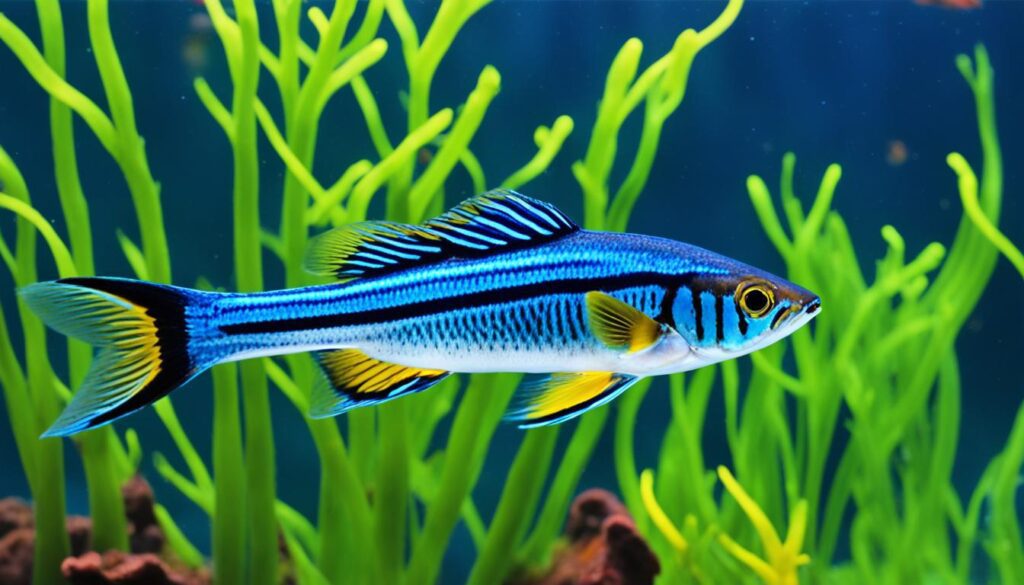
The Giant Danio is an awesome pick for your aquarium. With their vibrant colors and social personality, they really add a lot of life to a tank. Let’s take a closer look at what makes this species so special, including how long they can stick around when you give them the right care.
Eye-Catching Colors
Giant Danios have this stunning gold-and-blue color combo that really stands out. They can grow pretty big too, usually around 4-6 inches long, which makes them one of the larger members of the Danio family. And if you look closely, you’ll notice the males and females have slightly different looks, which just adds to their appeal.
Fun and Social Nature
These fish are super energetic and love being in groups. You’ll often see them zooming around the tank together, which is not only fun to watch but also helps keep things lively. They’re happiest with other fish that are as easygoing as they are, so they’re a great match for similar tank mates.
Lifespan and Keeping Them Healthy
On average, Giant Danios live about 5 to 7 years, but with good care, they can sometimes last even longer. The trick is to give them clean water, a healthy diet, and as little stress as possible. This will help prevent common issues like ich or mycobacteriosis from popping up.
Optimal Housing for Your Giant Danio

Creating the right home for Giant Danios goes beyond just making the tank look nice. It’s about giving them the right space, water quality, and environment that makes them feel at home. When setting up a tank for these active fish, understanding their needs is key.
Tank Size: Why Bigger is Better
Giant Danios are all about having room to move, and they thrive in open spaces. A 55-gallon tank that’s at least 36 inches long is ideal for them. While you can get by with a 30-gallon tank, it really needs to be long enough for them to swim freely. And don’t forget, they’re social fish, so having at least five or more together helps them feel comfortable, reduces stress, and lets them act the way they would in the wild.
Mimicking Their Natural Stream Environment
To really make your Giant Danios feel at home, try recreating their natural stream habitat. Use river gravel or sand for the bottom layer, then add a few hardy plants and some driftwood. Keep the middle of the tank open, though—that’s where they love to swim. This setup not only looks great but also mirrors the clear, fast-moving streams they come from. Plus, using a good filter to keep the water clean and oxygen-rich is crucial, as it mimics the fresh water they’re used to in the wild.
And one last thing—make sure the tank has a solid cover because these fish can really jump! By following these steps, you’re giving your Giant Danios a healthy, happy home that looks amazing too. It’s all about creating a little piece of nature where they can thrive, just like they would in the wild.
Feeding Schedules and Dietary Needs
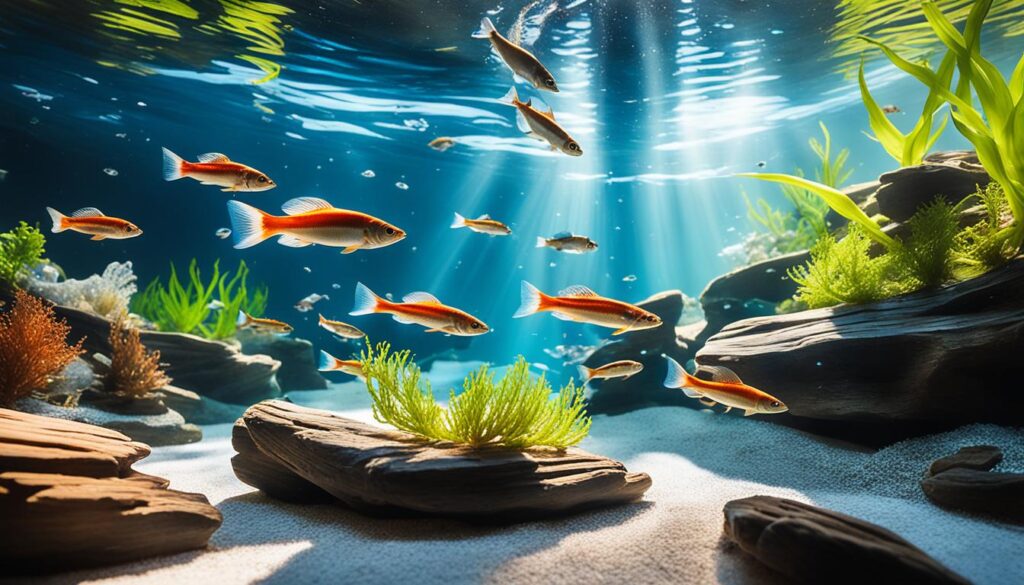
It’s key to manage a balanced diet for Giant Danios in aquarium care. They thrive on various foods to meet their needs. This mix boosts their health and makes their colors pop.
The Importance of a Diverse Diet
A mix of foods is important for Giant Danios’ diet. It ensures they get all the nutrients they need from both animals and plants. To keep them vibrant and healthy, include top-notch flake food, live snacks like brine shrimp, and veggies.
Tips on Providing Adequate Nutrition for Coloration and Health
Here are some ways to keep Giant Danios healthy and colorful:
- Multiple small feedings: Feed them little and often. This mimics their natural habits and helps avoid overfeeding.
- Live foods: Adding brine shrimp or bloodworms spices up their diet. This boosts their colors but use these treats carefully.
- Vegetable inputs: Mix in vegetables to keep their diet balanced. This helps keep them in top shape and colors bright.
By adopting a smart feeding plan and varying their meals, you’ll support your Giant Danios. This approach ensures they get all they need for growth and color, making your aquarium a lively, beautiful place.
Ensuring a Thriving Social Structure
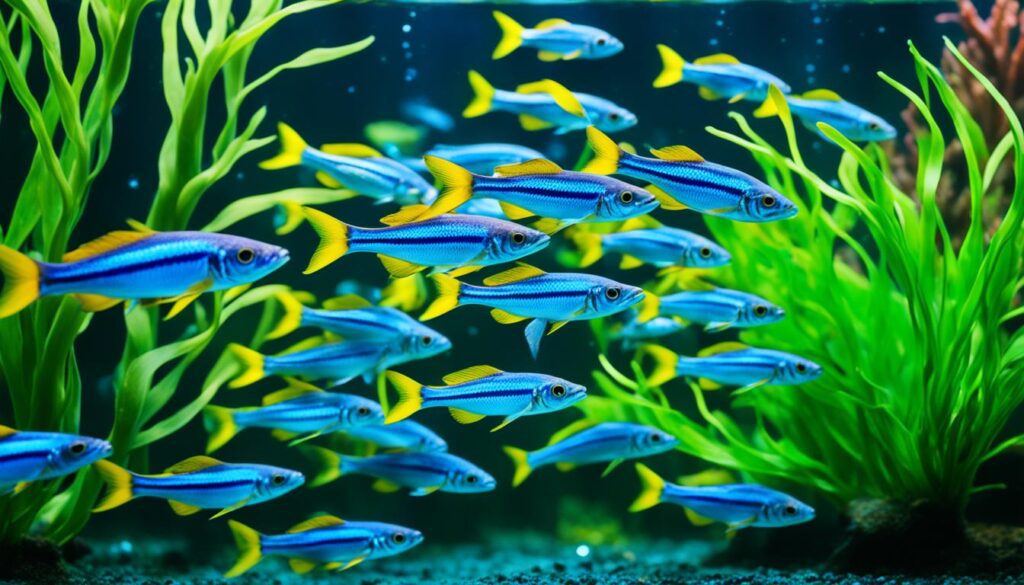
Giant Danio social behavior is super interesting. They need to be with others of their kind to be happy. This isn’t just a choice; it’s vital for their mental and social health. Creating an environment that supports their natural behaviors is key if you’re adding Giant Danios to your tank.
The Significance of Group Dynamics and Schooling
Giant Danios love to swim together. This not only helps them avoid predators but also is key for socializing. When in groups of six or more, they feel safer and less stressed. This makes them healthier and brighter in color. Being in a school makes them feel secure and reduces fights over territory.
Companionable Species for Your Giant Danio
Choosing the right tank mates for Giant Danios is important for a peaceful tank. They need friends who can keep up with their activity and need for space. Below is a list of tank mates that work well in a busy aquarium:
Species |
Compatibility |
Remarks |
|---|---|---|
Agassiz’s Dwarf Cichlid |
High |
Peaceful; enjoys similar water conditions |
Tiger Barbs |
Medium |
Can match the Danios’ energy but monitor for fin-nipping |
Cory Catfish |
High |
Peaceful bottom dwellers; good at keeping the tank clean |
Clown Loaches |
High |
Enjoys similar water temperature; beneficial for snail control |
Invertebrates (Shrimp, Snails) |
Medium |
Ensure no large fish in the tank that might predate on them |
It’s crucial to keep an eye on how fish get along in the tank. You might need to make changes based on what you see. But most importantly, make sure there are plenty of Giant Danios together. This is the best way to see their amazing social behaviors. With the right setup, you can create a lively and fascinating aquatic world.
Detailed Guide to Breeding Giant Danios
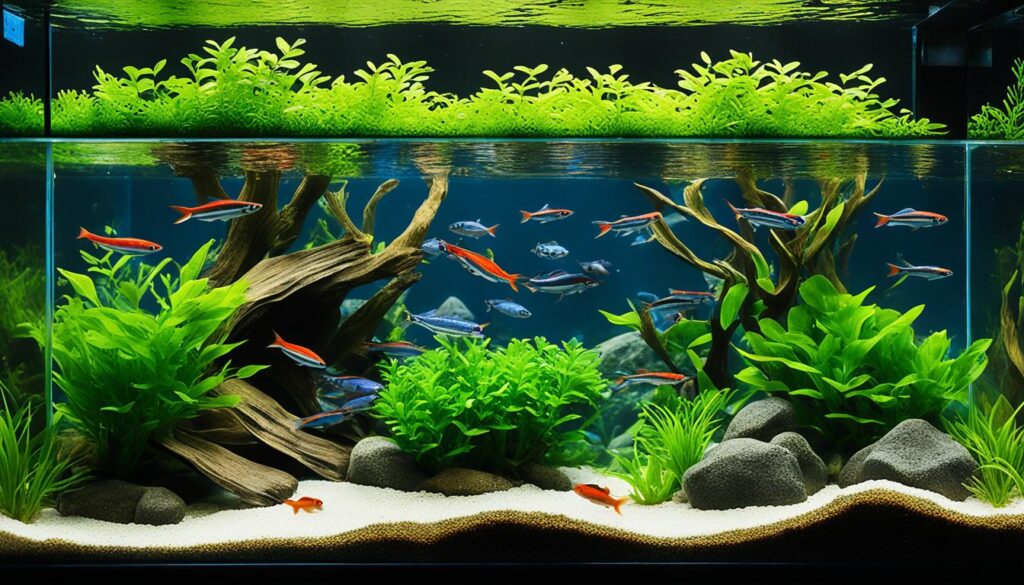
Welcome to the world of Breeding Giant Danios. This task is rewarding when done right. It’s vital to have a proper aquarium breeding setup. This setup aids the breeding process and ensures the spawning danios are successful. We’ll explore how to create the ideal breeding environment. Also, we will look at steps for spawning and caring for the fry.
Setting Up the Right Breeding Environment
To breed Giant Danios, the right environment is key. You should start with a 50-gallon tank. This size is perfect, giving the fish enough room. The tank needs fine-leafed plants or a spawning mop for egg laying. Water conditions matter too.
Keep the temperature between 77°F and 82°F and the pH below 7.0. These conditions help stimulate spawning danios. Make sure the water is clear and has plenty of oxygen. This is crucial for both adults and eggs.
Steps to Encourage Spawning and Fry Care
With your aquarium breeding setup in place, focus on spawning. Spawning happens early in the morning. Afterward, remove the adults to save the eggs. The eggs will hatch in 24 to 36 hours. Next is fry care.
Caring for the fry is vital for their survival and health. Start with finely ground food or freshly hatched brine shrimp. These are perfect for the little ones.
Condition |
Requirement for Breeding Giant Danios |
|---|---|
Tank Size |
At least 50 gallons |
Water Temperature |
77°F to 82°F |
pH |
Below 7.0 |
Spawning Setup |
Fine-leafed plants or spawning mop |
Fry Food |
Finely ground or freshly hatched brine shrimp |
To have success in breeding Giant Danios, manage these aspects well. With the right setup and attention to fry care, you’ll help a new generation thrive. All of this in your own home aquarium.
Giant Danio: Identifying and Preventing Common Diseases
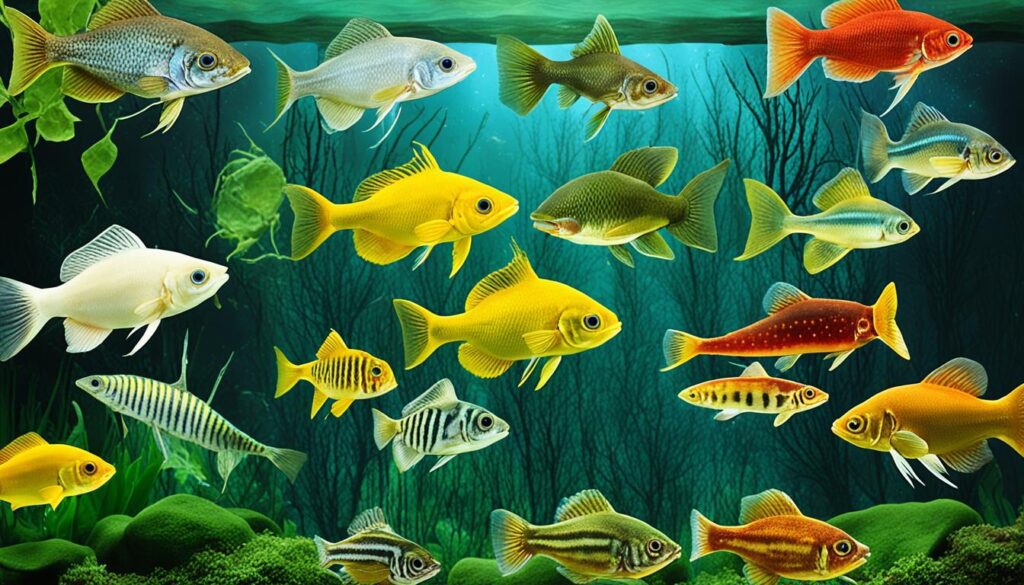
Keeping Giant Danios healthy means knowing what diseases they face. This includes ich and mycobacteriosis. Since these fish are lively and key to the aquarium’s ecosystem, stopping and treating these diseases is important.
Spotting Symptoms and Managing Ich
Ich, or white spot disease, affects many freshwater fish like Giant Danios. It is caused by a parasite, seen as small white spots on the fish. Fish might act irritated, rubbing against objects, or eat less. Spotting ich early and treating it is key.
To deal with ich, you can increase the tank’s temperature. This speeds up the parasite’s lifecycle. You can also use salt treatments or store-bought remedies. Treating the whole tank is important because ich affects all fish in it.
Understanding and Treating Mycobacteriosis in Your Tank
Mycobacteriosis shows up in Giant Danios as tiredness, weight loss, and skin sores. This bacterial disease is hard to cure, so it’s better to prevent it. A clean tank and high water quality are crucial.
If you think your fish has mycobacteriosis, isolate and treat it with antibacterial medicine. Getting advice from a vet who knows about fish diseases is a good idea. They can suggest medicines and treatments.
To avoid diseases in Giant Danios, always check the water. Keep the temperature between 17-27°C and pH levels from 6.5-8.0. Make sure there’s no ammonia or nitrite. Regular water changes and watching your fish closely can catch health issues early.
Remember, a healthy tank environment and well-informed care are your best tools in preventing diseases in your Giant Danios.
Advanced Care Techniques for the Dedicated Aquarist
As an avid aquarist, I’m always working to better the lives of my fish. Keeping Giant Danios healthy takes a watchful eye and following advanced Giant Danio care advice. It’s crucial to check the water’s chemistry often. A popular forum with over 13,000 views shared that changing pH levels can harm a tank. Members found that some substrates could cause problems, underlining the need for constant attention.
My circle of expert aquarium tips grows from 15 aquarists’ shared knowledge. They agree that introducing fish slowly is best. They discuss specialized fish care strategies too. From using strong guppies to fishless cycling, these methods are kind and show how fish care has evolved. At the heart of these practices is using gadgets like tap-to-tank water changers. This makes water upkeep much easier.
There’s a lot of talk about the best way to cycle tanks. Some prefer the old fish-in method, while others like fishless cycling. Conversations in fish stores showcase this variety of opinions. Using filter squeezings from established tanks can speed up cycling times. In forums and guides like Giant Danio: Care Guide, Breeding, Tank Setup &, there’s a shared goal. We all want our fish to thrive. This means careful water changes, smart fish choices, and regular checks. This ensures our Giant Danios keep swimming happily.








